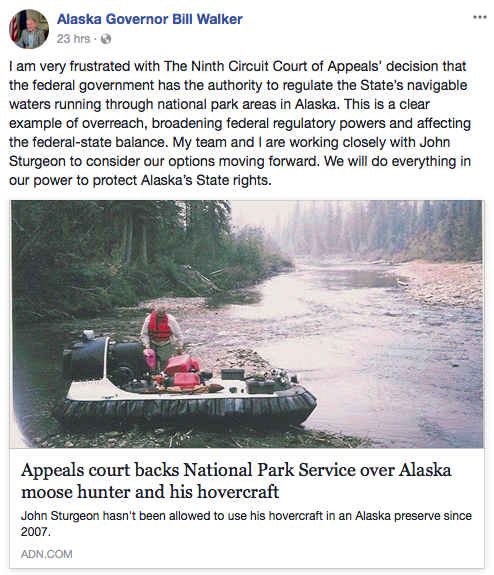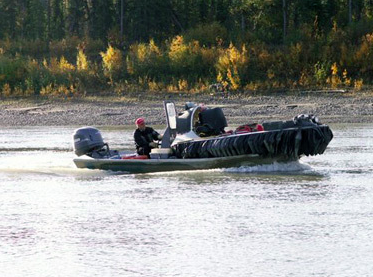Gov. Bill Walker on Wednesday said the State of Alaska will do everything in “our power to protect Alaska’s State rights.”
He was referring narrowly to State rights. Walker expressed frustration with the Ninth Circuit Court of Appeals decision in what is now a legendary hunting access case in Alaska that has gone on for more than a decade.
The court decision was so stunning in its overreach that even Alaska’s usually appeasing governor had to object to the newly expanded federal authority over the State’s navigable waters that run in and around national parks and refuges in Interior Alaska.
There’s not all that much that Walker can do, however. He could file a friend-of-the-court brief when Sturgeon once again goes back to the U.S. Supreme Court for relief from the U.S. Park Service, which Sturgeon most certainly will.
The State can’t take over the case, or pay for the case, or even join the case, even though Alaska has a dog in the fight because if Sturgeon can’t freely navigate the rivers of the Yukon-Charley Rivers National Preserve, then neither can the rest of us.
Walker’s Facebook pronouncement came after the Ninth Circuit ruling had been digested a bit and Alaska’s outdoor access community began to realize how much it impacts every hunter, fisherman, Native corporation, land owner, and even Alaska’s very state sovereignty.
The Ninth had not only emboldened federal overreach over an expanded swath of Alaska, and it also opened up the door on a controversial case known as “Katie John 1.” The ruling said that “Katie John 1” relied on the wrong set of laws, but since it had done so, the Sturgeon case would reflect that ruling.

It all started when hunter and outdoorsman Sturgeon attempted to used his hovercraft to access hunting grounds in Alaska in 2007.
Sturgeon assumed, as many had for decades before him, that navigable waters in Alaska are governed by the State, even though they run through federal land. That was part of the deal with the Alaska National Interest Lands Conservation Act signed by President Jimmy Carter in 1980.
BACKGROUND ON ANILCA
Congress struck a deal when it passed ANILCA and added 104 million acres to national parks, refuges, and wilderness.
Sen. Ted Stevens and Congressman Don Young had spent four years fighting for the rights of Native corporations and the State of Alaska to have economic and cultural opportunity on the lands acquired at Statehood and under the Alaska Native Claims Settlement Act.
ANILCA wasn’t perfect, but with Stevens’ and Young’s help, Congress at least had excluded navigable waterways from the 1980 ANILCA provisions.
But in 1996, the National Park Service adopted a regulation that gave it the authority to regulate activities on state waterways across the nation. They started using this authority in Alaska in spite of ANILCA’s “Alaska exception.”
Fast forward to 2007, when Sturgeon was stopped by the Park Service from using the Nations River as a water highway to hunting grounds. He sued the Park Service and lost in the Ninth Circuit Court, which said that federal regulations can be applied to all lands within the “exterior” boundaries of the parks.
Sturgeon appealed to the U.S. Supreme Court. They took the case.
The Supreme Court sided with Sturgeon unanimously, and said “Alaska is different.” But the high court remanded the case back to the Ninth Circuit so it could review its work, which the justices said was wanting.
The Ninth Circuit this week thumbed its nose at the Supreme Court and expanded federal authority to not only include Native corporation-owned and state-owned lands and waters within the boundaries of national parks in Alaska, but also on waterways outside of national parks and refuges.
The decision would affect abilities of Native corporations to establish commercial developments on their lands and the ability of the State to manage its lands as well as lands the State conveys to municipalities and individual Alaskans.
This is contrary to what ANILCA intended and what Congress promised 37 years ago.
KATIE JOHN CASE RAISES ITS HEAD?
The Ninth Circuit court based this expansion on a ruling the it made in what is known as “Katie John I.” In that lawsuit, the definition of “public lands” in ANILCA includes state waterways so that the subsistence laws applying to federal lands could be applied to state waterways.
That case languished without being taken further when Gov. Tony Knowles refused to defend state sovereignty back in the 1990s. Although Gov. Sean Parnell sought to clarify provisions of Katie John, Gov. Bill Walker walked away from it.
The ruling this week expanded federal authority. But in making its decision, the three-judge panel on the Ninth also implied that its own ruling on the Katie John decision was flawed because it was based on the United States Reserved Water Rights Act, rather on what it now says is more proper: The Commerce Clause.
That ruling may open the door to a future challenge or clarification of the Katie John decision, which gives the federal government control over Native subsistence hunting and fishing on navigable waters owned by the State, when those waters are adjacent to or inside of federal land holdings.
Katie John was an Athabascan elder who had sought to continue fishing along the Copper River, as her people had always done. Her case was meant to clean up a contradiction between federal law and the Alaska constitution. Federal law gives subsistence priority to rural Alaskans, while the state consitution gives equal access to resources.
As for John Sturgeon, he has a few days to decide on whether he’ll appeal to the U.S. Supreme Court once again. So far, his case has cost $750,000.

Impeach the Ninth Circuit, then free Alaska from its tyranny by giving us our own northwest federal appeals court.
We must act and act now to defend Alaskan citizens, land and resources. It is time to take back our land and take back our freedoms.